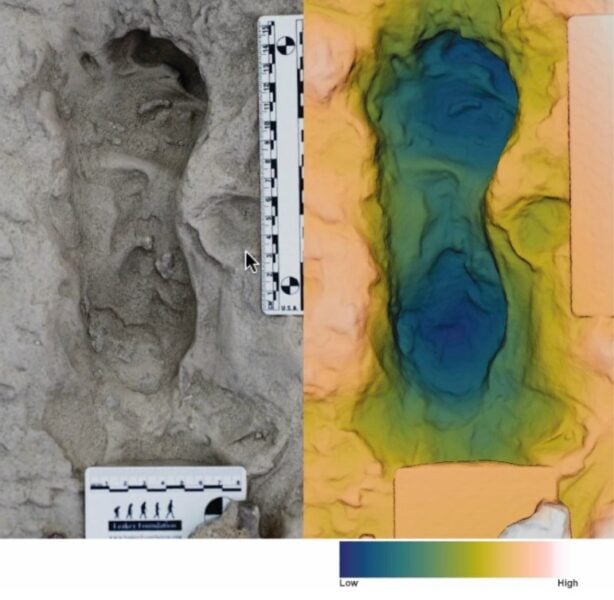A remarkable discovery in Kenya’s Turkana Basin has provided the first direct evidence that different human species coexisted and shared the same habitats 1.5 million years ago. The finding, described by Kevin Hatala and colleagues, offers unprecedented insights into the social dynamics of our ancient relatives.
Published in Science | Estimated reading time: 4 minutes
Until now, scientists could only infer the coexistence of different human species from scattered fossil discoveries with overlapping dates. The newly discovered footprints, preserved in ancient muddy sediments along what was once a lakeshore, tell a more direct story. These tracks show that at least two different species of early humans walked through the same space, likely within hours or days of each other, providing tangible evidence of shared habitats.
The research team, working at the famous fossil site of Koobi Fora, uncovered multiple sets of footprints that reveal distinctly different walking styles. Based on detailed analysis of foot motion and stance patterns preserved in these tracks, the researchers identified two different types of bipedalism – one matching the walking style of Homo erectus, and another showing characteristics consistent with Paranthropus boisei.
The site, designated as ET-2022-103-FE22, preserves one particularly notable trackway containing twelve footprints from a sequence of thirteen steps. This series of footprints shows unique characteristics in both the arch of the foot and the position of the big toe that distinguish it from known Homo erectus tracks. The footprints were made as these ancient humans walked along the submerged edge of a lake, alongside tracks from various animals including large birds, bovids, and equids.
Using sophisticated 3D modeling and comparative analysis with modern human footprints, the research team found that the newly discovered tracks exhibit patterns that fall well outside the range of variation seen in human footprints. The angle of the big toe and the structure of the arch suggest a foot anatomy and walking style distinct from both modern humans and previously discovered Homo erectus footprints from the same time period.
Glossary
- Bipedalism
- The ability to walk upright on two legs, a defining characteristic of humans and their ancestors
- Trackway
- A series of footprints made by the same individual walking in a particular direction
- Paranthropus boisei
- An early human species known for its robust skull and specialized chewing adaptations
- Relative arch volume (RAV)
- A measurement used to quantify the three-dimensional shape of the arch of the foot in fossilized footprints
Test Your Knowledge
What makes these footprint discoveries particularly significant for understanding human evolution?
They provide the first direct physical evidence of different human species using the same habitat at approximately the same time, rather than just inferring this from dated fossils found in different locations.
How did researchers determine that the footprints came from different species?
They analyzed the patterns of foot movement, arch structure, and big toe position, finding that some tracks showed characteristics distinctly different from known Homo erectus footprints and modern human variation.
What other evidence at the site helps contextualize the human footprints?
The site contains tracks from various animals including large birds (likely marabou storks), bovids, and equids, providing information about the shared ecosystem and environment.
What specific anatomical features helped distinguish between the different types of footprints?
The relative arch volume (RAV) and hallucial abduction (big toe position) showed patterns that fell outside the range of modern human and known Homo erectus variation, suggesting a different foot anatomy and walking style.
Enjoy this story? Subscribe to our newsletter at scienceblog.substack.com.
If our reporting has informed or inspired you, please consider making a donation. Every contribution, no matter the size, empowers us to continue delivering accurate, engaging, and trustworthy science and medical news. Independent journalism requires time, effort, and resources—your support ensures we can keep uncovering the stories that matter most to you.
Join us in making knowledge accessible and impactful. Thank you for standing with us!

